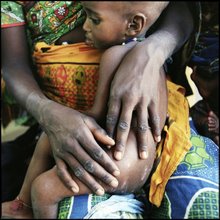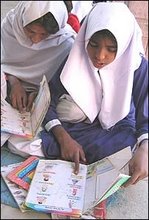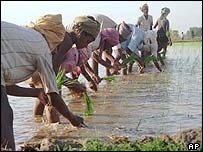PREAMBLE: The MDG Report 2012 was launched in New York by UN Secretary-General Ban Ki-moon on July 2, 2012. Several MDG targets have been met well ahead of the 2015 target date. The report states that meeting remaining targets remains possible if Governments keep their commitments made over a decade ago. Clearly this includes both recipient and donor nations.
Highlights of the Report:
Extreme poverty is falling in every region including Sub- Saharan Africa.
The poverty reduction target was met: the global poverty rate at $1.25 a day fell in 2010 to less than half the 1990 rate. If confirmed, the first target of the MDGs— cutting extreme poverty to half its 1990 level—will have been achieved at the global level well ahead of 2015.
The world has met the target of halving the proportion of people without access to improved sources of water: the proportion of people using an improved water source rising from 76 per cent in 1990 to 89 percent in 2010.
Improvements in the lives of 200 million slum dwellers exceeded the slum target: The share of urban residents in the developing world living in slums declined from 39 per cent in 2000 to 33 per cent in 2012. This achievement exceeds the target of significantly improving the lives of at least 100 million slum dwellers, well ahead of the 2020 deadline.
The world has achieved parity in primary education between girls and boys: Many more children are enrolled in primary school, especially since 2000. Girls benefited the most. The gender parity index value of 97 falls within the margin of error for 100.
Many countries facing the greatest challenges have made significant progress towards universal primary education. Enrolment rates of primary school age children increased markedly in sub-Saharan Africa, from 58 to 76 per cent between 1999 and 2010.
Child survival progress is gaining momentum. Despite population growth, the number of under-five deaths worldwide fell from more than 12.0 million in 1990 to 7.6 million in 2010.
Access to treatment for people living with HIV increased in all regions. At the end of 2010, 6.5 million people were receiving antiretroviral therapy for HIV or AIDS in developing regions. This total constitutes an increase of over 1.4 million people from December 2009, the largest one-year increase ever. The 2010 target of universal access, however, was not reached.
The world is on track to achieve the target of halting and beginning to reverse the spread of tuberculosis. Globally, tuberculosis incidence rates have been falling since 2002, and current projections suggest that the 1990 death rate from the disease will be halved by 2015.
Global malaria deaths have declined. The estimated incidence of malaria has decreased globally, by 17 per cent since 2000. Over the same period, malaria-specific mortality rates have decreased by 25 per cent. Reported malaria cases fell by more than 50 per cent between 2000 and 2010 in 43 of 99 countries with ongoing malaria transmission.
These accomplishments notwithstanding, there remain major challenges:
Inequality detracts from these gains, and advances have slowed: Achievements are unequally distributed across and within regions and countries. Moreover, progress has slowed for some MDGs after the 2008-9 economic crisis and related consequences.
Vulnerable employment has decreased only marginally over twenty years. Defined as share of unpaid family workers and own-account workers in total employment, this fell to 58 per cent from 67 per cent two decades earlier. Women and youth remain the most vulnerable.
Decreases in maternal mortality are far from the 2015 target. Despite improvements, progress is still slow. Reductions in adolescent childbearing and expansion of contraceptive use have continued, but at a slower pace since 2000 than over the decade before.
Use of improved sources of water remains lower in rural areas. While 19 per cent of the rural population used unimproved sources of water in 2010, the rate in urban areas was only 4 per cent. Nearly half of the population in developing regions still lack access to improved sanitation.
Hunger remains a global challenge. 850 million people lived in hunger in the 2006-8 period, 15.5 per cent of the world population. This continuing high level reflects lack of progress on hunger in several regions, even as income poverty decreased. Progress is slow in reducing child undernutrition. Close to one third of children in Southern Asia were underweight in 2010.
The number of people living in slums continues to grow. Despite a reduction in the proportion of urban populations living in slums, the absolute number continues to grow from a 1990 baseline of 650 million. An estimated 863 million people now live in slum conditions.
Gender equality and women’s empowerment remain key challenges. Gender inequality persists and women continue to face discrimination in access to education, work and economic assets, and participation in government. Violence against women continues to undermine efforts to reach all goals.
REFERENCE:
United Nations. The Millennium Development Goals Report 2012. New York 2012. http://mdgs.un.org/unsd/mdg/Resources/Static/Products/Progress2012/English2012.pdf
FROM a Great Canadian and World Statesman
"A great gulf... has... opened between man's material advance and his social and moral progress, a gulf in which he may one day be lost if it is not closed or narrowed..."
Lester B Pearson
http://nobelprize.org/nobel_prizes/peace/laureates/1957/pearson-lecture.html
Sunday, 15 July 2012
MILLENNIUM DEVELOPMENT GOALS - 2012 REPORT HIGHLIGHTS
INSPIRATIONAL WELCOME ............................... from T.S.Eliot's "Little Gidding"
If you came this way From the place you would come from... It would be the same at the end of the journey...
If you came, not knowing what you came for, It would be the same... And what you thought you came for Is only a shell, a husk of meaning... From which the purpose breaks only when it is fulfilled If at all.


























